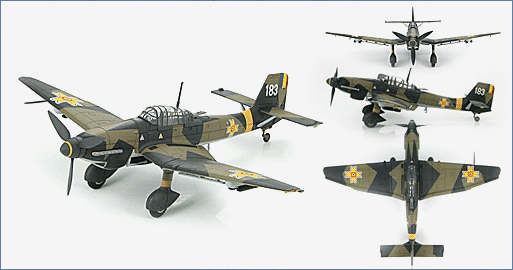Air Power Series>1:72 die-cast display model>Ju87>HA0155
Ju-87 D3 "Stuka" 183, Royal Romanian Air Force, Jassi 1943

General Background
The Ju 87 was considered as one of the most important German military aircrafts during WWII. It was better known as the “Stuka” which means “Dive Bomber”.
While the Ju 87 achieved great success during the beginning of WWII due to its accuracy in bombing, it suffered from lack of speed and defense armament. Without the escort of German fighters the Stuka easily became preys for enemy high speed fighters. After the Battle of Britain the Ju 87 was seldom seen in actions in the continent.
In 1940, the Ju 87 D (the “Dora” series), with a more powerful engine Jumo 122F, was developed for the attack of heavily defended targets. In 1943, with the approaching invasion of Russia, the Ju87 G “Gustav” was developed for anti-tank purpose. It was fitted with two 37mm cannons under the main wing and the number 1 ace of it was the legendary Oberst (Colonel) Hans Ulrich Rudel who had achieved over 500 kills of Russian armor include one battle ship destruction.The Aircraft
Late 1940 through 1943 the Royal Romanian Air Force (Fortele Aeriene Regale ale Romaniei –
FARR) received 155 Ju-87s of variants -1, -2, -3 and -5s to replace the obsolete French and
British aircraft they had been using. The aircraft were given to the 3rd Dive Bomber Group and
also later the 6th Dive Bomber Group operated within the 3rd Bomber Flotilla. Their main task
was to provide air support for the ground troops which they did and received much praise from
the troops and the Fliegerkorps. In June 1944 the group were flying missions in support of the
Axis troops fighting on the River Mius. Then in July the 3rd Dive Bomber Group was moved to
the Kerch peninsula to provide air support for troops at the Kuban bridgehead. The Stukas were
tasked with many types of missions and within 2 to 3 months had suffered damage to 31 of the
45 aircraft they received. On August 20, 1944 Soviet forces began an offensive at Yassy (Jassy
– Jassi – Iassy) and Tiraspol in eastern Romania. The attacks by the 3rd and 6th Romanian Dive
Bomber Group managed to destroy or damage a lot of Soviet equipment but were unable to stop
their progress. On August 23, 1944 realizing that they were supporting the losing side Romanian
King Michael announced that his country had reached an armistice with the Allies and they were
about to switch sides. They now helped the Soviets liberate parts of Romania that were under
German control. By late 1944 the Romanian Air Force once again found themselves with limited
numbers of aircraft and a scarcity of spare parts so their effectiveness basically came to an end
at this time.
Specifications :
| Type: | Single Engined Medium Bomber |
| Power Plant: | 1 X 1,440hp Junkers Jumo 211J, 12 cylinder in line, water cooled |
| Wingspan: | 45ft 3.25in (13.80m) |
| Length: | 36ft 1in (11.00m) |
| Height: | 12ft 9.5in (3.90 m) |
| Wing Area: | 362.7sq ft (33.60 sq m) |
| Empty weight: | 8,686lbs (3,940 kg) |
| Loaded weight: | 14,550lbs (6,600 kg) |
| Max Speed: | 255mph (410 km/h) |
| Climbing Rate: | 3000 meters in 14 minutes |
| Max range: | 410mi (660 km) |
| Service Ceiling: | 27,885ft (8,500 m) |
| Armament: | 2 x 20mm MGH151/20 one in each wing, |
| 1x7.92mm MG81machine gun, rear cockpit, | |
| Ordnance: | 1x 551 lb (250 kg) or 1x 1,103 lb (500 kg) |
| or 1x 2205 lb (1,000 kg) bomb under fuselage, plus 4x 551 lb | |
| 250 kg) or 2x 1103 lb (500 kg) bombs under wings. Maximum load - 3,500 lbs. |

